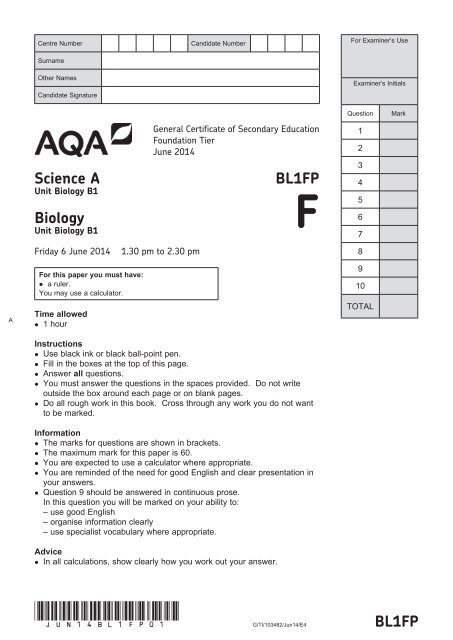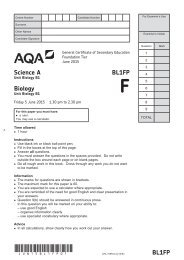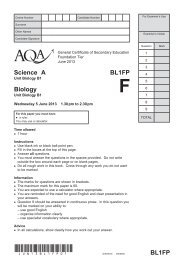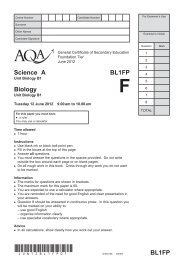B1-Foundation-June 2014
You also want an ePaper? Increase the reach of your titles
YUMPU automatically turns print PDFs into web optimized ePapers that Google loves.
Centre Number<br />
Surname<br />
Candidate Number<br />
For Examiner’s Use<br />
Other Names<br />
Candidate Signature<br />
Examiner’s Initials<br />
Question<br />
Mark<br />
Science A<br />
Unit Biology <strong>B1</strong><br />
Biology<br />
Unit Biology <strong>B1</strong><br />
Friday 6 <strong>June</strong> <strong>2014</strong><br />
General Certificate of Secondary Education<br />
<strong>Foundation</strong> Tier<br />
<strong>June</strong> <strong>2014</strong><br />
1.30 pm to 2.30 pm<br />
BL1FP<br />
F<br />
1<br />
2<br />
3<br />
4<br />
5<br />
6<br />
7<br />
8<br />
A<br />
For this paper you must have:<br />
• a ruler.<br />
You may use a calculator.<br />
Time allowed<br />
• 1 hour<br />
Instructions<br />
• Use black ink or black ball-point pen.<br />
• Fill in the boxes at the top of this page.<br />
• Answer all questions.<br />
• You must answer the questions in the spaces provided. Do not write<br />
outside the box around each page or on blank pages.<br />
• Do all rough work in this book. Cross through any work you do not want<br />
to be marked.<br />
Information<br />
• The marks for questions are shown in brackets.<br />
• The maximum mark for this paper is 60.<br />
• You are expected to use a calculator where appropriate.<br />
• You are reminded of the need for good English and clear presentation in<br />
your answers.<br />
• Question 9 should be answered in continuous prose.<br />
In this question you will be marked on your ability to:<br />
– use good English<br />
– organise information clearly<br />
– use specialist vocabulary where appropriate.<br />
Advice<br />
• In all calculations, show clearly how you work out your answer.<br />
9<br />
10<br />
TOTAL<br />
(Jun14BL1FP01)<br />
G/TI/103482/Jun14/E4<br />
BL1FP
2<br />
Do not write<br />
outside the<br />
box<br />
There are no questions printed on this page<br />
DO NOT WRITE ON THIS PAGE<br />
ANSWER IN THE SPACES PROVIDED<br />
(02)<br />
G/Jun14/BL1FP
3<br />
Do not write<br />
outside the<br />
box<br />
Answer all questions in the spaces provided.<br />
1 Figure 1 shows a cell.<br />
Figure 1<br />
Nucleus<br />
1 (a) Draw a ring around the correct answer to complete each sentence.<br />
chromosomes.<br />
1 (a) (i) In the nucleus of a cell, genes are part of<br />
membranes.<br />
receptors.<br />
[1 mark]<br />
1 (a) (ii) Different genes control different<br />
characteristics<br />
gametes<br />
of an organism.<br />
nuclei<br />
[1 mark]<br />
1 (a) (iii) Studying the similarities and differences between organisms allows us to<br />
classify<br />
clone<br />
the organisms.<br />
grow<br />
[1 mark]<br />
1 (b) Complete the following sentence.<br />
[1 mark]<br />
Living things can be grouped into animals, microorganisms and .................................... .<br />
____<br />
4<br />
Turn over <br />
(03)<br />
G/Jun14/BL1FP
4<br />
Do not write<br />
outside the<br />
box<br />
2 A student investigated growth in plants.<br />
The student:<br />
● planted a seed in damp soil in a plant pot<br />
● put the plant pot in a dark cupboard.<br />
Figure 2 shows the result after 5 days.<br />
Soil surface<br />
Figure 2<br />
Shoot<br />
Damp soil<br />
Plant pot<br />
Seed<br />
Root<br />
2 (a) Draw a ring around the correct answer to complete each sentence.<br />
away from water.<br />
2 (a) (i) After the 5 days, the root had grown<br />
in the direction of the force of gravity.<br />
towards light.<br />
[1 mark]<br />
against the force of gravity.<br />
2 (a) (ii) After the 5 days, the shoot had grown<br />
away from light.<br />
towards water.<br />
[1 mark]<br />
(04)<br />
G/Jun14/BL1FP
5<br />
Do not write<br />
outside the<br />
box<br />
2 (b) After the plant had grown, the student put the plant pot by a window with lots of light.<br />
Figure 3 shows this.<br />
Figure 3<br />
Window<br />
Light<br />
2 (b) (i) Complete Figure 4 to show the appearance of the student’s plant after 20 days by the<br />
window.<br />
[1 mark]<br />
Figure 4<br />
Window<br />
Light<br />
2 (b) (ii) Explain the advantage to the plant of growing in the way that you have drawn in<br />
part (b)(i).<br />
[2 marks]<br />
............................................................................................................................................<br />
............................................................................................................................................<br />
............................................................................................................................................<br />
............................................................................................................................................<br />
____<br />
5<br />
Turn over <br />
(05)<br />
G/Jun14/BL1FP
6<br />
Do not write<br />
outside the<br />
box<br />
3 A healthy diet contains the right balance of different foods and the right amount of<br />
energy.<br />
3 (a) An unbalanced diet can lead to health problems.<br />
One problem caused by an unbalanced diet is being overweight.<br />
Name one health problem, other than being overweight, that is linked to an<br />
unbalanced diet.<br />
[1 mark]<br />
............................................................................................................................................<br />
3 (b) Sugar is a type of carbohydrate.<br />
3 (b) (i) Eating too much sugar can make a person overweight.<br />
Suggest why.<br />
[1 mark]<br />
............................................................................................................................................<br />
............................................................................................................................................<br />
3 (b) (ii) Which other substance in food is linked to people being overweight?<br />
Draw a ring around the correct answer.<br />
[1 mark]<br />
fat mineral ions vitamins<br />
(06)<br />
G/Jun14/BL1FP
7<br />
Do not write<br />
outside the<br />
box<br />
3 (c) Sugar substitutes taste sweet.<br />
Taking sugar substitutes helps to reduce the chance of becoming overweight.<br />
Table 1 gives information about four sugar substitutes, A, B, C and D.<br />
Table 1<br />
Sugar<br />
substitute<br />
Number of times<br />
sweeter than sugar<br />
Effects on health<br />
A x 200 Harmful to some people<br />
B x 250 Not known<br />
C x 600 Not known<br />
D x 500 None<br />
3 (c) (i) Which sugar substitute, A, B, C or D, is the sweetest?<br />
[1 mark]<br />
3 (c) (ii) A person is advised to use sugar substitute D and not sugar substitutes A, B or C.<br />
Suggest a reason why.<br />
[1 mark]<br />
............................................................................................................................................<br />
............................................................................................................................................<br />
3 (c) (iii) A food has a sugar substitute in it.<br />
Why must it say on the packet which sugar substitute it is?<br />
[1 mark]<br />
............................................................................................................................................<br />
............................................................................................................................................<br />
____<br />
6<br />
Turn over <br />
(07)<br />
G/Jun14/BL1FP
8<br />
Do not write<br />
outside the<br />
box<br />
4 Drugs affect the human body.<br />
4 (a) Draw one line from each drug to the correct information about the drug.<br />
[4 marks]<br />
Drug<br />
Information<br />
Used to boost heart rate<br />
Cannabis<br />
Used to treat leprosy<br />
Steroid<br />
May cause mental illness<br />
in some people<br />
Stimulant<br />
Used to increase muscle<br />
growth<br />
Thalidomide<br />
Used to treat measles<br />
4 (b) New drugs must be tested and trialled before being used.<br />
4 (b) (i) New drugs are tested in a laboratory before they are trialled on people.<br />
What are new drugs tested on in a laboratory?<br />
[1 mark]<br />
............................................................................................................................................<br />
(08)<br />
G/Jun14/BL1FP
9<br />
Do not write<br />
outside the<br />
box<br />
4 (b) (ii) Why is it important that drugs are trialled before doctors give them to patients?<br />
Tick () two boxes.<br />
[2 marks]<br />
To check that the drug works<br />
To check the cost of the drug<br />
To find out if the drug is legal<br />
To find the best dose to use<br />
4 (b) (iii) In a double blind drug trial, only some people know which patients have been given<br />
the drug.<br />
Who knows which patients have been given the drug?<br />
Tick () one box.<br />
[1 mark]<br />
The patient and the doctor<br />
Only the doctor<br />
Only scientists at the drug company<br />
Question 4 continues on the next page<br />
Turn over <br />
(09)<br />
G/Jun14/BL1FP
10<br />
Do not write<br />
outside the<br />
box<br />
4 (c) Doctors trialled four different treatments for reducing the risk of heart disease.<br />
Each treatment was trialled on the same number of patients for 5 years.<br />
The patients did not have heart disease at the start of the trial.<br />
Figure 5 shows the results.<br />
450<br />
Figure 5<br />
400<br />
350<br />
Number of<br />
patients who<br />
needed<br />
treatment for<br />
heart disease<br />
during the trial<br />
300<br />
250<br />
200<br />
150<br />
100<br />
50<br />
0<br />
Aspirin<br />
Beta<br />
blockers<br />
Diuretics<br />
Statins<br />
Treatment<br />
4 (c) (i) How many patients who took aspirin needed treatment for heart disease during the<br />
trial?<br />
[1 mark]<br />
Number of patients = .............................................<br />
4 (c) (ii) Based only on the evidence in Figure 5, which would be the best treatment to reduce<br />
the risk of developing heart disease?<br />
[1 mark]<br />
............................................................................................................................................<br />
4 (c) (iii) Suggest one other factor that a doctor might consider before deciding which treatment<br />
to use for a patient.<br />
[1 mark]<br />
............................................................................................................................................<br />
____<br />
11<br />
(10)<br />
G/Jun14/BL1FP
11<br />
Do not write<br />
outside the<br />
box<br />
Turn over for the next question<br />
DO NOT WRITE ON THIS PAGE<br />
ANSWER IN THE SPACES PROVIDED<br />
Turn over <br />
(11)<br />
G/Jun14/BL1FP
12<br />
Do not write<br />
outside the<br />
box<br />
5 Most cows produce milk with a fat content of 3.4%.<br />
Cow S produces milk with a fat content of 1.2%.<br />
Only cow S has the gene to produce this low-fat milk.<br />
5 (a) A farmer plans to develop more cows like cow S.<br />
Figure 6 shows how the farmer plans to do this.<br />
Figure 6<br />
Cow S<br />
x<br />
Bull (male)<br />
Fertilise an egg cell<br />
from cow S with a<br />
sperm cell from a bull<br />
Original embryo<br />
Take cells from<br />
original embryo<br />
Allow cells to develop<br />
into new embryos<br />
Put new embryos<br />
into host mothers<br />
Host mothers give<br />
birth to calves<br />
5 (a) (i) An egg cell from cow S is fertilised by a sperm cell from a bull. This is part of<br />
sexual reproduction.<br />
What is the scientific name for sex cells such as egg cells and sperm cells?<br />
[1 mark]<br />
............................................................................................................................................<br />
(12)<br />
G/Jun14/BL1FP
13<br />
Do not write<br />
outside the<br />
box<br />
5 (a) (ii) After fertilisation, cells are taken from the original embryo.<br />
These cells develop into new embryos.<br />
Which part of the host mother’s body should each new embryo be put into?<br />
[1 mark]<br />
............................................................................................................................................<br />
5 (b) (i) The calves born to all of the host mothers are genetically identical to each other.<br />
Draw a ring around the correct answer to complete the sentence.<br />
[1 mark]<br />
The calves are genetically identical to each other because<br />
are formed from the same original embryo.<br />
they<br />
have the same host mother.<br />
have the same two parents.<br />
5 (b) (ii) What term is used to describe the method of producing calves shown in Figure 6?<br />
Tick () one box.<br />
[1 mark]<br />
Adult cell cloning<br />
Embryo transplantation<br />
Genetic modification<br />
5 (b) (iii) Why are the calves born to the host mothers not genetically identical to cow S?<br />
[1 mark]<br />
............................................................................................................................................<br />
............................................................................................................................................<br />
____<br />
5<br />
Turn over <br />
(13)<br />
G/Jun14/BL1FP
14<br />
Do not write<br />
outside the<br />
box<br />
6 This question is about evolution in humans.<br />
Figure 7 shows:<br />
● the estimated brain volume of different species of humans<br />
● the time when the different species existed on Earth.<br />
The data is plotted for modern humans (Homo sapiens) and for three types of extinct<br />
ancestors of humans.<br />
Figure 7<br />
2000<br />
Homo sapiens<br />
(modern humans)<br />
1600<br />
Estimated<br />
brain<br />
volume<br />
1200<br />
800<br />
in cm 3 1 0<br />
Australopithecus<br />
afarensis<br />
Trend<br />
Homo habilis<br />
Homo erectus<br />
400<br />
0<br />
4<br />
3 2<br />
Millions of years ago<br />
Key<br />
Each point plotted on the graph shows the estimate for one human.<br />
6 (a) (i) As humans evolved, their brain volume changed.<br />
What has happened to human brain volume over the past 4 million years?<br />
[1 mark]<br />
............................................................................................................................................<br />
............................................................................................................................................<br />
(14)<br />
G/Jun14/BL1FP
15<br />
Do not write<br />
outside the<br />
box<br />
6 (a) (ii) Why is the evidence for estimated brain volume for Homo sapiens stronger than the<br />
evidence for Australopithecus afarensis?<br />
[1 mark]<br />
............................................................................................................................................<br />
............................................................................................................................................<br />
6 (b) In a book, the brain volume of a different species, Australopithecus africanus, is stated<br />
to be about 600 cm 3 .<br />
Use evidence from Figure 7 to estimate when Australopithecus africanus lived on<br />
Earth.<br />
[1 mark]<br />
Estimate = .................................. million years ago<br />
6 (c) Scientists believe that modern humans evolved by natural selection from<br />
Australopithecus afarensis.<br />
6 (c) (i) Complete the following sentence.<br />
[1 mark]<br />
In the nineteenth century, the scientist who suggested the theory of evolution by<br />
natural selection was Charles ........................................................ .<br />
6 (c) (ii) In the nineteenth century, many people did not accept this scientist’s theory.<br />
Give one reason why.<br />
[1 mark]<br />
............................................................................................................................................<br />
............................................................................................................................................<br />
____<br />
5<br />
Turn over for the next question<br />
Turn over <br />
(15)<br />
G/Jun14/BL1FP
16<br />
Do not write<br />
outside the<br />
box<br />
7 Figure 8 shows the pathway for a simple reflex action.<br />
Figure 8<br />
Sharp pin<br />
Neurone X<br />
Neurone Z<br />
Gap<br />
Neurone Y<br />
Muscle<br />
Spinal cord<br />
7 (a) What type of neurone is neurone X?<br />
Draw a ring around the correct answer.<br />
[1 mark]<br />
motor neurone relay neurone sensory neurone<br />
7 (b) There is a gap between neurone X and neurone Y.<br />
7 (b) (i) What word is used to describe a gap between two neurones?<br />
Draw a ring around the correct answer.<br />
[1 mark]<br />
effector receptor synapse<br />
7 (b) (ii) Draw a ring around the correct answer to complete the sentence.<br />
[1 mark]<br />
a chemical.<br />
Information passes across the gap as<br />
an electrical impulse.<br />
pressure.<br />
(16)<br />
G/Jun14/BL1FP
17<br />
Do not write<br />
outside the<br />
box<br />
7 (c) Describe what happens to the muscle when it receives an impulse from neurone Z.<br />
How does this reflex action help the body?<br />
[2 marks]<br />
What happens to the muscle .............................................................................................<br />
............................................................................................................................................<br />
How this helps the body .....................................................................................................<br />
............................................................................................................................................<br />
____<br />
5<br />
Turn over for the next question<br />
Turn over <br />
(17)<br />
G/Jun14/BL1FP
18<br />
Do not write<br />
outside the<br />
box<br />
8 Food chains show the flow of energy through the organisms in a habitat.<br />
8 (a) Figure 9 shows a food chain.<br />
Figure 9<br />
grass sheep human<br />
The biomass in each stage of the food chain changes as food passes along the<br />
food chain.<br />
Draw a pyramid of biomass for this food chain.<br />
Label the pyramid.<br />
[2 marks]<br />
(18)<br />
G/Jun14/BL1FP
19<br />
Do not write<br />
outside the<br />
box<br />
8 (b) Table 2 shows three food chains, A, B and C.<br />
Table 2<br />
Food chain<br />
A plants sheep human<br />
B plants grasshoppers frogs trout human<br />
C plants human<br />
8 (b) (i) In which food chain, A, B or C, will the greatest proportion of biomass and energy of<br />
the plants be passed to humans?<br />
[1 mark]<br />
8 (b) (ii) Give reasons why the food chain that you chose in part (b)(i) passes on the greatest<br />
proportion of biomass and energy to humans.<br />
[3 marks]<br />
............................................................................................................................................<br />
............................................................................................................................................<br />
............................................................................................................................................<br />
............................................................................................................................................<br />
............................................................................................................................................<br />
............................................................................................................................................<br />
____<br />
6<br />
Turn over for the next question<br />
Turn over <br />
(19)<br />
G/Jun14/BL1FP
20<br />
Do not write<br />
outside the<br />
box<br />
9 In this question you will be assessed on using good English, organising<br />
information clearly and using specialist terms where appropriate.<br />
Animals and plants have features (adaptations) that allow them to survive in the<br />
conditions in which they normally live.<br />
Describe how animals and plants are adapted to survive in dry conditions such as<br />
deserts.<br />
For each adaptation that you give, describe how the adaptation helps the animal or<br />
plant to survive in dry conditions.<br />
To obtain full marks you should refer to both animals and plants.<br />
[6 marks]<br />
............................................................................................................................................<br />
............................................................................................................................................<br />
............................................................................................................................................<br />
............................................................................................................................................<br />
............................................................................................................................................<br />
............................................................................................................................................<br />
............................................................................................................................................<br />
............................................................................................................................................<br />
............................................................................................................................................<br />
............................................................................................................................................<br />
............................................................................................................................................<br />
............................................................................................................................................<br />
Extra space ........................................................................................................................<br />
............................................................................................................................................<br />
............................................................................................................................................<br />
............................................................................................................................................<br />
............................................................................................................................................<br />
............................................................................................................................................<br />
............................................................................................................................................<br />
____<br />
6<br />
(20)<br />
G/Jun14/BL1FP
21<br />
Do not write<br />
outside the<br />
box<br />
Turn over for the next question<br />
DO NOT WRITE ON THIS PAGE<br />
ANSWER IN THE SPACES PROVIDED<br />
Turn over <br />
(21)<br />
G/Jun14/BL1FP
22<br />
Do not write<br />
outside the<br />
box<br />
10 Most birds sit on their eggs to keep them warm until they hatch.<br />
Megapode birds:<br />
● dig a large hole in sand<br />
● fill the hole with dead plants<br />
● lay their eggs on top of the dead plants<br />
● cover the surface with a thick layer of sand.<br />
Figure 10 shows a megapode bird’s nest.<br />
Figure 10<br />
Air vent<br />
Eggs<br />
Sand<br />
Dead plants<br />
10 (a) The dead plants in the nest decay. The decaying process helps to keep the eggs warm<br />
for many weeks.<br />
Suggest how.<br />
[3 marks]<br />
............................................................................................................................................<br />
............................................................................................................................................<br />
............................................................................................................................................<br />
............................................................................................................................................<br />
............................................................................................................................................<br />
............................................................................................................................................<br />
(22)<br />
G/Jun14/BL1FP
23<br />
Do not write<br />
outside the<br />
box<br />
10 (b) (i) Megapode birds open and close the air vents of the nest at different times of the day.<br />
Suggest reasons why it is necessary to open and close the air vents.<br />
[3 marks]<br />
............................................................................................................................................<br />
............................................................................................................................................<br />
............................................................................................................................................<br />
............................................................................................................................................<br />
............................................................................................................................................<br />
............................................................................................................................................<br />
10 (b) (ii) The sex of a megapode bird that hatches from an egg depends on the temperature at<br />
which the egg was kept.<br />
Use this information to suggest why it is important for megapode birds to control the<br />
temperature of their nests.<br />
[1 mark]<br />
............................................................................................................................................<br />
............................................................................................................................................<br />
____<br />
7<br />
END OF QUESTIONS<br />
(23)<br />
G/Jun14/BL1FP
24<br />
Do not write<br />
outside the<br />
box<br />
There are no questions printed on this page<br />
DO NOT WRITE ON THIS PAGE<br />
ANSWER IN THE SPACES PROVIDED<br />
Acknowledgement of copyright-holders and publishers<br />
Permission to reproduce all copyright material has been applied for. In some cases, efforts to contact copyright-holders have been unsuccessful and<br />
AQA will be happy to rectify any omissions of acknowledgements in future papers if notified.<br />
Figure 6:<br />
© Thinkstock<br />
Copyright © <strong>2014</strong> AQA and its licensors. All rights reserved.<br />
(24)<br />
G/Jun14/BL1FP






